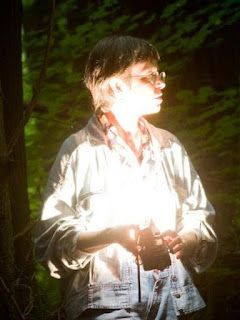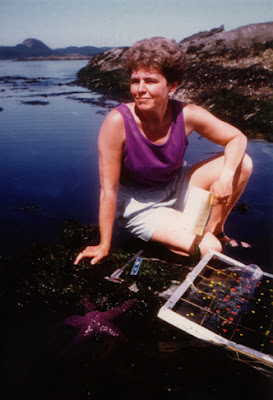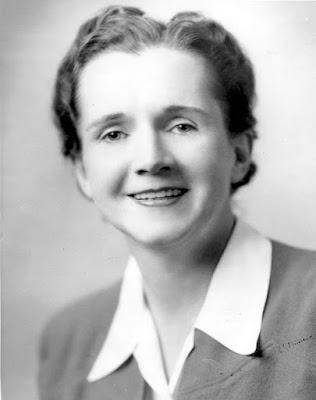Today is Ada Lovelace Day, and we are joining in the 7th annual world celebration of the contributions made by women to STEM fields. Named in honor of one of the pioneers of computer programming, this day affords us the opportunity to highlight the accomplishments of women who we admire in these fields. Here, biograds introduce and discuss women who have been important to their pursuit of science.
Barbara McClintock
(by Marie Clifford)
An amazing, tenacious woman scientist who discovered movable genetic elements called transposons in the 1940s. She was basically ignored and left to do more awesome genetics research in corn, her model system, for 40 years while people thought that (1) she was crazy and (2) that genes were totally static. And then it came to light that actually transposons are found in pretty much every living thing and she won a Nobel Prize for Physiology or Medicine in 1983. (P.S. Nobel prizes for people doing plant science are almost non-existent, even when people discover important things in plants first like RNAi or gaseous hormones or whatever … so this is kind of a big deal.) Beyond being super interesting from an academic perspective, transposons are super important in medicine: transposons are the elements that often convey antibiotic resistance from one bacterium to another, and can be mutagens, so have been implicated in cancer. They have also been used as an important tool for understanding how particular genes work in many organisms, with applications for plant genetics, cancer genetics, and beyond. [Ed: She is also the only woman to receive an unshared Nobel in Phys/Med]
Terry Root
(by Leander Anderegg)

I’m not sure that I would be a biologist, perhaps a scientist of any sort, if it weren’t for Dr. Terry Root. Terry is a scientific bigwig. She’s a world renowned ecologist (her most cited paper on the ecological fingerprints of climate change has been cited over 3,000 times). She’s a brilliant scientific mind, a co-recipient of a Nobel Peace Prize (she was a lead author of the Prize winning IPCC’s Fourth Assessment Report on climate change), and an inspiring public speaker (even on depressing topics). And yet Terry is also one of the most dedicated science educators I have ever met.
When I met Terry, she was a Stanford Professor who was so busy that one had to email her, call her, and then camp outside her office for 1-2 days to get hold of her. I was a wide-eyed freshman, straight from the lovely hamlet of Cortez, CO (a town of 8,500 people four hours from the nearest city), who was chagrined to learn that somehow all 2000 of my classmates were smarter, more well read, funnier, and better groomed than I was. I began working for her as a research assistant because she was nice, and because my brother had gotten me the job, and because she had awesome pictures of birds in her office. By the end of the year, Terry had not only convinced me to become an ecologist, but had taught me more about science and how it is performed than four years of classes possibly could.
As a graduate student in the 80s, Terry was a rare female scientist in a generation of primarily male ecologists. Perhaps because of this, she is a first rate meta-scientist who taught me that science cannot be separated from the human factors (social interactions, intrinsic gender and racial bias, implicit world views). Sure, Terry taught me a lot of practical things. Terry taught me that if you can’t draw a graph of your expected results before you start a project, it’s probably not worth doing. She taught me how to make a powerpoint presentation that will keep >50% of an audience engaged and >75% awake. She taught me that most other scientists don’t really know what they’re doing most of the time either. But Terry also taught me that science is a fundamentally human endeavor, and should be viewed and analyzed as such. (Photo Credit)
Nina Sandlin
(by Meera Lee Sethi)

Nina Sandlin works as a communications strategist and technology wizard in Chicago (need help with Perl? Nina’s your girl!). She earned a Masters degree in history, not a Ph.D. in biology or paleontology or computer science. Nina isn’t, at least not officially, a professional scientist. So why am I celebrating her on Ada Lovelace Day? Well, I—like many of you, probably—am a big fan of spiders, museum collections, and taxonomy. And for the last 17 years, Nina has made it her life’s mission to help museum curators figure out what they’re looking at, when they’re looking at some of the most difficult-to-identify spiders in North America. She’s creating a photographic key to genus for the only Nearctic spiders that don’t yet have one: female erigonine “dwarf spiders” belonging to the family Linyphiidae. Why don’t they already have a key? You’ll have to read my profile of Nina and her work to find out. It involves cat whiskers, sweater fibers, and that old “too many elbows for the photograph” problem.
I’ve heard people say, “Science is what scientists do”; but that’s not true, today or any other day. Science is the process of making knowledge. Nina is doing exactly that.
Photo: Field Museum
For more on Nina Sandlin: A recent presentation Nina gave at the meeting of the American Arachnological SocietyThe new LinEpig website
Jane Lubchenco
(by Hilary Hayford)
 |
| Jane Lubchenco with P. ochraceus and quadrat. Photo: SciFun.org |
One of the many women in science that I greatly admire is Dr. Jane Lubchenco. I admire Dr. Lubchenco not only for her rigorous science, but for the leadership roles she’s taken in applied conservation, improving science communication, and promoting women and families in academic science.
Dr. Lubchenco is considered “royalty” in the field of marine ecology, but if you keep up on alums you know she was a UW grad student of Bob Paine, earning a Master’s in Zoology (1971) for work on sea star competition. (Never fear, botany faithful, her dissertation at Harvard (1975) was greatly focused on seaweeds and herbivory). Her body of work targets interactions between humans and the marine environment, particularly marine reserves and sustainable fisheries.
Dr. Lubchenco is most well known as the first woman to be appointed as Undersecretary of Commerce for Oceans and Atmosphere and Administrator of the National Oceanic and Atmospheric Association (NOAA), serving 2009-2013. President Obama selected her to lead the country in marine issues. During her tenure she faced such challenges as the BP/Deepwater Horizon Oil Spill and the Tohoku Earthquake/Tsunami. In another example of her leadership, Dr. Lubchenco co-founded the Partnership for Interdisciplinary Studies of Coastal Oceans (PISCO), a long-term research and monitoring program studying the California Current Large Marine Ecosystem. A collaboration of four universities receiving nearly $90 million of funding in its first 10 years, PISCO was unprecedented in the field of marine ecology in its scale, scope, and budget.
Dr. Lubchenco has served as President of the American Association for the Advancement of Science (AAAS) and the Ecological Society of America (ESA), received the Mac Arthur Genius Award and 18 honorary doctorates, is an elected member of the National Academy of Sciences, the Royal Society… the list of accolades is very, very long. Despite this legacy of outstanding accomplishments, she has consistently taken time to mentor and support developing scientists. She has advocated for effective science communication (co-Founder of COMPASS) and participated in numerous panels/seminars on women in STEM. Dr. Lubchenco and her husband inspired a new approach to the struggle of academia and family by negotiating a novel arrangement with Oregon State University: splitting a full-time, tenure-track professorship, with each scientist working 50% time until their sons were grown.
Rachel Carson
(by Audrey Ragsac)
When I think of women in STEM, the name Rachel Carson always comes to my mind. While most know that her writings helped spur the global environmental movement of the 1960s, few are probably aware that she was an also an accomplished scientist. Raised in rural Pennsylvania, she developed a love for nature by exploring the forests and streams surrounding her family’s farm. In 1929, she graduated with a Bachelors degree in biology from the Pennsylvania College for Women and was subsequently awarded a scholarship to pursue a Masters degree in zoology and genetics at Johns Hopkins University, a remarkable accomplishment for a woman at that time. After completing her studies, she became an aquatic biologist for the U.S. Bureau of Fisheries, where she analyzed and reported data on fish populations, as well as communicated her work to the public via both brochures for the Bureau as well as articles in The Baltimore Sun. After publishing her first book, Under the Sea Wind, Carson transitioned to science writing full time. Her second book, The Sea Around Us, was an enormous success, remaining on the New York Times Bestseller list for 86 weeks. However, her most famous work stemmed from experiences she had while still associated with the Bureau. Carson was disturbed by the increased use of synthetic pesticides after World War II and their effects on marine wildlife. After several years of research on the subject, Carson warned the public about the long-term effects of misusing pesticides, especially DDT, in the classic book Silent Spring. This seminal work contains a detailed investigation on the effects of insecticides and pesticides on songbird populations in the U.S., whose declining numbers yielded the silence to which her title speaks. The publication of this text sparked a wave of environmental legislation, including the banning of DDT, and galvanized the ecological movement still alive today.
Rachel Carson’s life inspires and motivates me in so many ways. She broke the status quo by studying science and pursuing professional degrees at a time when it was uncommon for women to do so. She was also courageous to write about a controversial subject knowing that the backlash she would receive from the pesticide industry and similar entities would be far less harmful than the effects of these chemicals on both the environment and public health. Lastly, her work demonstrates that it is possible to start a global movement by wielding just your ideas and voice, and it reminds me of the importance of communicating my research and scientific ideas to the public.




